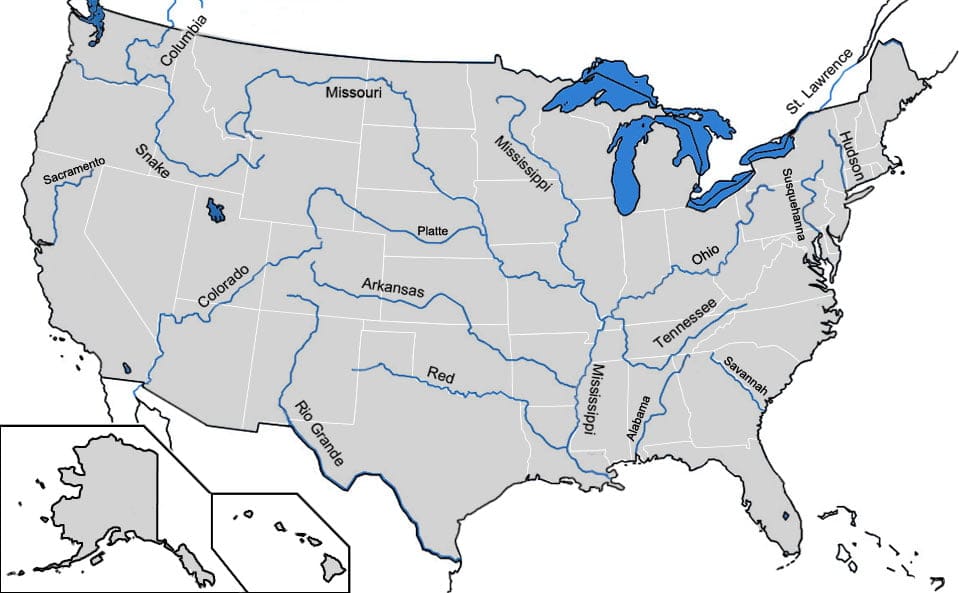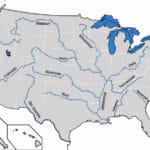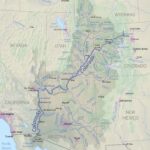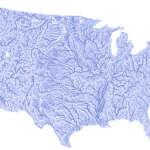Grab a seat and let’s set sail on a journey that’ll likely take you to the soul of our country. We’ll ride the waves of the Mississippi and the mighty Missouri, two rivers that have played a starring role in shaping who we are as a nation. Along the way, you’ll get a taste of the wild, the lively cities, and the stories that make these waterways so special. Get ready for a captivating adventure that’ll show you our beloved rivers from a whole new perspective!
Two Largest Rivers in the US: A Tale of Two Giants
The United States, with its breathtaking landscapes and natural wonders, boasts two rivers that stand as giants among its waterways: the mighty Mississippi and the sprawling Missouri. These two rivers, forever intertwined, have shaped the history and geography of the nation.
Let’s start with the Mississippi, often called the “Father of Waters.” It stretches over 2,300 miles, starting as a humble stream in Minnesota and eventually flowing into the Gulf of Mexico. Along its journey, the Mississippi meanders through the heartland of America, touching ten states and creating a vital artery for trade, transportation, and life itself.
The Mississippi’s story is one of constant change. Its waters, a muddy brown from the sediment it carries, have carved out valleys and created fertile deltas, supporting a rich diversity of plants and animals. It’s a river that has inspired countless stories and songs, a testament to its hold on the American imagination.
Then there’s the Missouri, a river that seems to embody the spirit of the Wild West. It begins high in the Rocky Mountains of Montana, gathering strength as it flows eastward for over 2,300 miles before finally merging with the Mississippi just north of St. Louis.
The Missouri was once known as the “Big Muddy” due to the massive amounts of sediment it carries downstream. This sediment, deposited over millennia, created the fertile farmlands that make up the Great Plains. Historically, the Missouri was a crucial route for explorers, fur traders, and settlers seeking their fortunes in the West.
While the Mississippi is slightly longer, some argue that the Missouri, with its numerous tributaries, actually drains a larger area. Regardless of which river claims the title of “longest,” both are undeniably vital to the American ecosystem and economy. They provide drinking water, irrigation for crops, and transportation routes for goods.
Here’s a table summarizing some key differences:
| Feature | Mississippi River | Missouri River |
|---|---|---|
| Length | Approximately 2,320 miles | Approximately 2,341 miles |
| Source | Lake Itasca, Minnesota | Rocky Mountains, Montana |
| Mouth | Gulf of Mexico | Mississippi River |
| States Traversed | 10 states | 7 states |
| Nicknames | “Father of Waters” | “Big Muddy,” “Mighty Mo” |
Exploring these rivers is like taking a journey through American history and natural beauty. But, it’s important to remember that our understanding of these complex ecosystems is always evolving. Scientists are constantly studying the impact of human activities on these rivers, looking at issues like pollution, damming, and climate change.
There’s still much to learn about these magnificent rivers, and that’s part of what makes them so fascinating. They remind us that nature is full of wonder and that we have a responsibility to protect these precious resources for generations to come.
What are the 2 Major Rivers in North America?
While the Amazon River takes the title of the longest river in the Americas, North America boasts its own impressive waterways: the Mississippi and Missouri Rivers. These rivers are giants in their own right, significantly impacting the surrounding landscape and people.
The Mississippi, often called the “Father of Waters,” lives up to its name. This massive river flows over 2,300 miles from Minnesota to the Gulf of Mexico, cutting through the heart of the US and passing through ten states. The Mississippi has carved out valleys and formed fertile deltas over time, providing fertile land for farming and a habitat for diverse plants and animals. Beyond nature, millions rely on the Mississippi for drinking water, crop irrigation, and transportation, making it a lifeline for communities.
The Missouri River, originating in the Rocky Mountains, covers an astounding 2,300 miles before joining the Mississippi. Nicknamed the “Big Muddy” and the “Mighty Mo,” it carries a large amount of sediment, contributing to the fertile Great Plains. Like the Mississippi, the Missouri is a crucial transportation route, plays a vital role in irrigation, and helps control floods.
These rivers are not just impressive for their size; they are integral to the history, culture, and economy of North America. They facilitated exploration and trade, inspired art, and continue to be vital resources for millions. Protecting these natural wonders is crucial for future generations.
What are the Largest and Second-Largest Rivers in America in Terms of Discharge?
Rivers are essential to our continent, shaping the land and connecting ecosystems. But when it comes to the sheer volume of water flowing through them, two rivers in America stand out.
The Mighty Mississippi: A River on a Mission
The Mississippi River holds the crown for the largest river in America by discharge. This incredible waterway travels over 2,300 miles, releasing an average of 562,000 cubic feet of water per second into the Gulf of Mexico, equivalent to over two Olympic-sized swimming pools every second. The Mississippi’s influence is vast — its drainage basin, spanning 31 states and two Canadian provinces, supports various ecosystems and creates fertile deltas teeming with wildlife.
The Ohio River: A Tributary with True Grit
The Ohio River claims the title of the second largest river in America by discharge, pouring a massive 275,000 cubic feet of water into the Mississippi every second – that’s like ten swimming pools worth! Originating in the hills of western Pennsylvania, this impressive river gracefully winds through six states, serving as a vital drain for much of the eastern United States. Beyond its beauty, the Ohio River is essential for transportation, providing drinking water to millions and irrigating farmlands across the nation.
Things to Remember About These Watery Giants:
- The Mississippi River reigns supreme: It’s the undisputed champion of discharge in America, moving over 562,000 cubic feet of water per second.
- The Ohio River is a strong contender: Coming in a respectable second place, it contributes a massive 275,000 cubic feet per second to the Mississippi.
- These rivers are essential to life as we know it: Both play crucial roles in shaping the land, supporting diverse ecosystems, and providing vital resources to people.
Is the Mississippi River the 2nd Largest River in the World?
The Mississippi River is undeniably long, but is it the second-longest river in the world? It’s a bit more nuanced than that. While the Mississippi proudly claims the title of North America’s second-longest river, it actually falls short of its tributary, the Missouri River.
The Mississippi stretches an impressive 2,350 miles, meandering through the heart of the US, connecting ten states from Minnesota to Louisiana. However, the Missouri River, flowing in from the west, drains a larger area of land and contributes more water to their confluence.
The Mississippi remains significant. Its massive drainage basin, covering over a million square miles, collects water from 31 US states and parts of Canada. The Mississippi is also teeming with life, from catfish and walleye to the ancient-looking garfish.
Here’s a recap:
- The Mississippi is the second-longest river in North America, covering a massive distance of 2,350 miles and flowing through ten states.
- The Mississippi’s drainage basin is huge, covering over 1.2 million square miles.
- This river is a haven for all sorts of aquatic life, making it incredibly important for the environment.
- However, the Missouri River is actually longer and drains an even larger area, making it the true giant of the two.
The Mississippi River might not be the absolute longest river, but it’s still an impressive and important waterway, vital to the American landscape and a testament to the power of nature.
Is the Missouri or Mississippi River Longer?
Both the Mississippi and Missouri Rivers are giants, flowing through America’s heart and shaping its history. But when it comes down to length, which river reigns supreme?
The Missouri River takes the crown, stretching an impressive 2,540 miles, surpassing the Mississippi’s respectable 2,340 miles. That’s like driving from New York City to Los Angeles and beyond!
Picture the Missouri as a massive, winding serpent, starting its journey in the Rocky Mountains and cutting through seven states – Montana, North Dakota, South Dakota, Nebraska, Iowa, Kansas, and Missouri – before meeting the Mississippi.
Don’t underestimate the Mississippi! Although technically shorter, it’s arguably more famous. The Mississippi starts its journey from Lake Itasca in Minnesota, flowing to the Gulf of Mexico and covering ten states.
The Mississippi has always been a vital artery for America, transporting goods, connecting communities, and inspiring countless songs and stories. From Native American life to the days of early settlers, the Mississippi has witnessed substantial history.
These rivers are more than just neighbors; they are practically family! The Missouri is the Mississippi’s largest tributary, supplying it with a considerable amount of water. They finally meet near St. Louis, Missouri, and from there, their waters flow together to the Gulf.
While the Missouri River claims the title of “longest” in the U.S., both rivers significantly contribute to America’s landscape, history, and culture. They serve as a powerful reminder of how nature shapes a nation.
Did you know that the longest river in the world is the Nile? It stretches an astounding 6,650 km with a drainage basin area of 3,536,000 square kilometers, accounting for 10% of the total length of the world’s rivers. To learn more about the longest river in the world, click on the link provided.
- Sept 31 Myth: Unveiling Calendar Secrets - March 18, 2025
- How Long & Till December 18, 2025: Accurate Countdown Guide - March 18, 2025
- Discover Japanese Artists: A Complete History - March 18, 2025
















